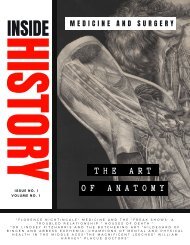InsideHistoryDigital
Create successful ePaper yourself
Turn your PDF publications into a flip-book with our unique Google optimized e-Paper software.
The fleas carrying the plague that laid in dormant<br />
soon woke up again during the summer of 1666.<br />
That particular summer, it was remarkably hotter in<br />
Eyam that the previous year, It was the perfect<br />
conditions for the fleas to continue spreading their<br />
pestilence.<br />
By August, the death toll in Eyam was rising.<br />
reaching a peak of up to six deaths a day. Seven of<br />
those deaths all came from the same family. In the<br />
space of eight days in August, Elizabeth Hancock<br />
had buried her seven children and her husband<br />
close to her family farm.<br />
In total, 260 villagers from 76 families would die in<br />
Eyam. However, the actions of Mompesson and the<br />
inhabitants of Eyam no doubt saved thousands of<br />
lives in the surrounding areas by their actions.<br />
William Mompesson would survive the plague and<br />
would eventually move to a new parish in Eakring,<br />
Nottinghamshire. He would remarry in 1670 to<br />
Elizabeth Newby. The thoughts of Eyam would<br />
always remain with him until his passing in 1709.<br />
Today, the village is known as "The Plague Village."<br />
The village itself has become a place of historical<br />
importance with plaques around the houses<br />
recalling the victims.<br />
The church of St Lawrence still stands. The stainglassed<br />
windows tell the story of the village's<br />
courage during that time. It is a legacy that<br />
continues to live on.<br />
PLAGUE FACTS<br />
It was known as the "Black Death"<br />
during the 14th Century, causing<br />
an estimated 50 million deaths<br />
There are three forms of plague<br />
infection: bubonic, septicaemic and<br />
pneumonic. Bubonic, characterised<br />
by painful swollen lymph nodes or<br />
'buboes', is the most common form<br />
The burying of the dead was an all too common<br />
experience for the villagers. Marshall Howe, would<br />
not only bury his own family but also many<br />
villagers. Howe was inflected during the early<br />
outbreak in 1665 yet he had survived. Believing<br />
himself to be immune he took on the post of<br />
burying the dead.<br />
Catherine Mompasson was busy tending to the sick<br />
to make their forthcoming deaths more tolerable. It<br />
was inevitable that she would eventually succumb<br />
to the disease herself. On the 23rd August,<br />
Catherine died at the age of 27.<br />
Plague still is endemic in many<br />
countries. The three most endemic<br />
countries are Madagascar, the<br />
Democratic Republic of Congo and<br />
Peru<br />
From 2010 to 2015 there were<br />
3248 cases reported worldwide,<br />
including 584 deaths.

















